Exposed List of SEO Terms that are absolutely essential for gaining traffic
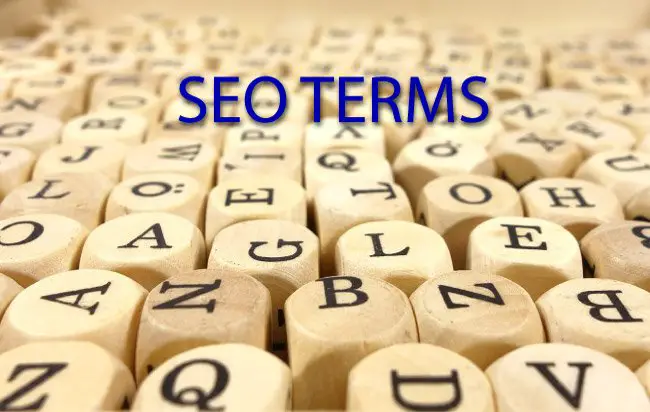
Every day, we look at lots of SEO Terms here and there on the internet, but could not understand the meanings of most of them. If you are a content marketer, SEO professional, website owner or any way related to some Internet service then it becomes utmost important to know the meanings of these terms.
The importance of SEO can be considered in the fact that 72% of marketers consider SEO as a successful mean to achieve their marketing objectives.
SEO is broadly classified into 2 main categories which are On-page SEO and Off-page SEO. All SEO Terms are related to these two categories so let’s first discuss about them.
On-page SEO
For doing On-page SEO, you optimize the pages for their content and HTML source code. This involves a lot of things like –
- 1. Putting proper Page Title and Meta Description in the pages.
- 2. Putting “alt” tag in all the images that are contained by the page.
- 3. Setting proper URL of pages.
- 4. Making website Responsive.
- 5. Internal linking between related contents.
- 6. Removing duplicate contents if any.
- 7. Good navigation between pages.
The purpose of On-page SEO is to make the website excellent to use for it’s users.
In terms of Search Engines, the On-page SEO tells them that the website is properly optimized and should be given good rankings, in Search Engine Results Page (SERP), for the keywords it is targeting.
Off-page SEO
For doing Off-page SEO, you do all the activities in external websites, that help to improve it’s position in SERP. This involves making links in external websites by writing articles and blogs in those websites. Video, photo sharing, popularizing your website Social Medias, are other means of doing Off-Page SEO.
The purpose of Off-page SEO is to let Search Engines to find signals to your site, from around the internet, and that forces Search Engines to give good rank to your website.
SEO Terms Glossary
Google receives over 100 billion searches every month. So if you do SEO correctly then you can get a good amount of traffic. Let us discuss all the SEO Terms in Alphabetical order.
0-9
301 Redirect
– A permanent redirect from one URL to another. It tells Search Engines of a change in the URL. 301 Redirect passes all Link Juice to the redirected URL, forcing Search Engines to index it and remove the old URL from their SERP.
If there is a change of URL, due to any reason, then makes sure to do 301 Redirect else the page ranking will take a hit.
302 Redirect
– A temporary redirect from old to new URL. Here Search Engines will continue to index the old URL and treats new URL as duplicate.
It leads to duplication as Search Engines finds the same content in more than one page. Therefore SEO experts mostly have a same opinion of not using this redirect on websites.
403 Error
– Access to the URL or resource is forbidden. Some website prevents users from certain countries to access them, for this they show 403 Error to these users.
404 Error
– Error due to URLs not found on a website. For example try opening a random URL in Google, like here I opened “www.google.com/abcd” and got 404 Error.
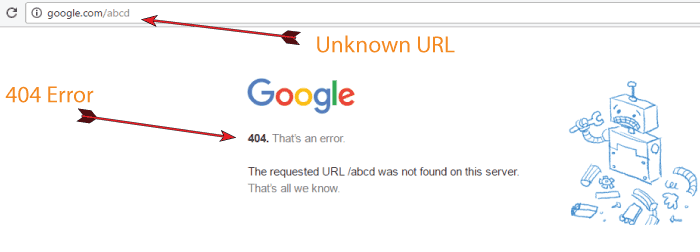
A website should build a good 404 page which gives a proper message to users regarding not found URL.
My website’s 404 page contains a message, search box, and Articles You May Like section. This helps in giving better user experience and also reduces the bounce rate.
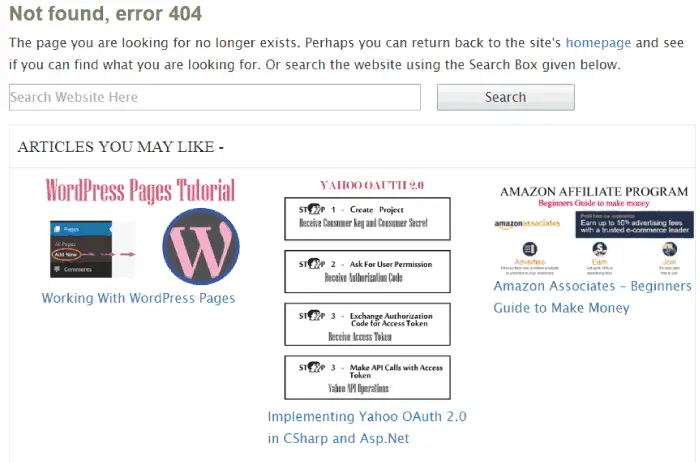
503 Error
– Service unavailable due to some temporary problem. A URL showing this error signifies that that server is down due to overloading, maintenance, or some other problem and will be resolved soon.
A
ALT Tag
– A description of the image so that Search Engines can understand what the image is all about. It is advisable to keep keywords in the alt text.
The alt tag applies only to the img elements, and it’s format is:
<img src="image url" alt="image description"/>
Anchor
– The link on a web page is called the anchor.
It is formed by HTML a tag. Example:
<a href="Link URL">Link Text</a>
Use anchor tag to target a keyword so that the link juice flows to the URL. The more link juice flows to the URL the better Search Engine rank the URL gets.
This is how to make a links which targets a keyword:
<a href="Link URL">Keyword</a>
When doing Off-page SEO, make links in authority sites, that are related to your website (authority site is discussed below). This will bring good rankings to your site.
Anchors can have 4 attributes: “nofollow”, “sponsored”, “ugc” & “dofollow”. The last one (“dofollow”) is the default. Each attributes signifying a different meaning.
<a href="Link URL" rel="dofollow">Keyword</a>
<a href="Link URL" rel="nofollow">Keyword</a>
<a href="Link URL" rel="sponsored">Keyword</a>
<a href="Link URL" rel="ugc">Keyword</a>
rel="sponsored" : Use the sponsored attribute to identify links on your site that were created as part of advertisements, sponsorships or other compensation agreements.
rel="ugc" : UGC stands for User Generated Content, and the ugc attribute value is recommended for links within user generated content, such as comments and forum posts.
Other attributes explained on the below sections.
Analytics
– Gathering and analyzing traffic details of a website like – which pages are receiving most traffic, the country wise traffic to the website, most linked pages, etc.
Authority site
– A website that is trusted by Search Engines for a topic *or topics) is called an authority website. They receive good rankings in SERP for their topics (usually in top 3 positions). This is the reason why they receive large traffic from Search Engines.
They also get a large number of incoming links from trusted websites.
Authority websites are also respected by knowledgeable people in its industry.
Take for example Wikipedia which is the authority site for the topic Abraham Lincoln.
B
Backlinks
– The incoming links, to your website, which are located on external websites. Backlinks made in authority websites are one of the biggest factors for ranking your website high in SERP.
Moreover, 1 Backlink in an authority website has a value much greater than 10,000 backlinks in low-quality websites.
Blog
– A blog is a section in a website where contents are placed in an orderly manner and divided into categories, sub-categories, tags and pages. WordPress is the most popular free blogging platform which can be installed in any domain.
Bookmarking
– Saving links either in some bookmarking websites like Mix or in the web browser’s bookmarking area. Bookmarking links is a positive factor for the website SEO.
Many SEO experts believe that Google collects the individual bookmarks of user’s Chrome browser, and the URL’s that are bookmarked in Chrome browser get preference in Google SERP.
Black Hat SEO
– The tactics that are used to manipulate or target only Search Engines and not the only human audience. These tactics are banned by search engines, and if a site is found implementing them then search engines impose huge penalties.
- Buying links for your website.
- Posting Duplicate contents in your website.
- Any type of spamming like comment posting, making hundreds of low quality links in low quality websites, sending excessive emails to sell your product / service, etc.
- Cloaking (explained in the below section).
Matt Cutts, who remained head of the Google Web Spam Team till January 2017, once said that 99% of the time Google accurately finds the website that has bought paid link.
Bot
– A software program that is designed to automatically perform the task given to them.
- Chatbots that simulate a conversation with human users. They are usually found in online chat rooms.
- Transactional Bots that acts as agents and perform some type of transaction for users.
Taco Bell bot does tocos ordering and payment for users through chat conversion itself. - Informational Bots that automatically provides you some type of information. Twitter has the largest number of information bots like this bot that Tweets about earthquakes as they happen.
- Search Engine Crawlers that extract information from web pages, for indexing purpose and building the search results.
- Scrapers are the one that copies other website’s pages and duplication them in their own website. If you find your website content being copied by different websites then it can be the act of some scraper bot.
Breadcrumb
– The navigational links that are placed just above the content in every page, and shows your current location of the user in the website. For example, if you are in the ‘about-us’ page then it will show – Home >> About.
On a product page, take for example “Mini Skirt”, which is under the category “Women’s Clothing”, it will show – Home >> Women’s Clothing >> Mini Skirt.
Bounce Rate
– The percentage of single-page sessions (the % of people leaving website from the entrance page itself). Bounce rate is an extremely important ranking factor and Search Engines look at them on every site. A website having higher bounce rate is considered as lower quality.
High bounce rates sites do not get good rank in SERP. It simply means that users are not receiving proper information on your website and they do not like your content.
When it is a case on your site, make strong efforts to overcome this problem.
Greater than 70% bounce rate sites suffer a lot in terms of organic traffic and SERP rankings.
C
Canonical URL
– If two or more pages of your website have their content almost same then you will face duplicate content issues. Moreover search engines will penalize your website.
To solve this issue you can place Canonical Tag on all these pages (and leaving one). Point them to the page that is left. The left page is also called as Original Page.
Take for example suppose pages ‘a’, ‘b’, ‘c’ have same content then you can place canonical tag in 3 different ways –
- 1. Placing canonical tag on pages ‘b’ and ‘c’, and pointing to ‘a’.
- 2. Placing canonical tag on pages ‘a’ and ‘c’, and pointing to ‘b’.
- 3. Placing canonical tag on pages ‘a’ and ‘b’, and pointing to ‘c’.
Canonical Tag is placed inside the page HTML head tag. Its syntax is –
<link rel="canonical" href="original page url" />
You can also use canonical tag for pages of different websites.
Content
– It is the information presented in a page that is of some interest to the user. The common example is the articles and blogs you put in a website.
CMS
– CMS stands for Content Management System, they help in publishing user’s content easily to his website. CMS takes care of everything including page and blog creation, image addition, URL and menu structure, while the user can concentrate only on content creations.
WordPress is one of the World’s most widely used CMS as of today.
Conversion
– Fulfillment of a task like a user registration on the website, submitting a contact form, sale, leads generation, etc are examples of a conversion.
CPC
– Full form Cost Per Click also known as PPC (Pay Per Click), an Internet advertisement method where an advertiser pays to the publisher for each click on his ads.
The advertisers who want to show their ads on other’s website can use Google Ads.
Similarly if you want to earn money by showing CPC ads on your website then you can use Google Adsense.
According to Google, businesses make $2 for every $1 they spend in CPC ads.
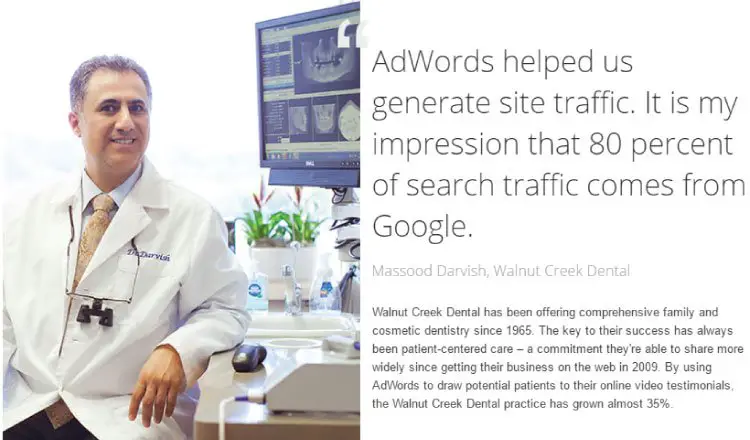
CPM
– Stands for Cost Per Thousand Impressions, is another Internet advertisement method where advertisers are charged based on the price of 1000 impression of his ads.
For example, $5 CPM means the advertisers pays $5 for every 1000 impressions of his ads.
Crawler (Search Engine Spiders)
– A program that moves on the internet and collects data from different websites. Examples are Google, Bing, and Yahoo Crawlers.
Cloaking
– A black hat SEO technique in which the content shown to Search Engine Bots is different to that shown to human visitors. This is meant to give a rank boost to the website for certain keywords.
Some ways how Cloaking is done –
- 1. Showing a page to humans where there are lots of images while for search engine bots the page shows only text.
- 2. Inserting extra text to a page whenever some user visits the website.
Clickthrough rate
– A Factor to measure how well your ads are performing. Its formula is: Number of clicks an ad received divided by number of times it is shown (impressions).
D
Disavow Links
– Backlinks from the bad website, like that of gambling, spamming, child pornography, unauthorized pharmacies and those which violates Google policies, will get your website penalized by Google.
These types of backlinks are also known as Toxic links. Make sure you remove all such links.
If under some circumstances you are unable to remove any such Toxic links then you can ask Google to disavow these links i.e. not to take these links into account.
Google Disavow Links helps you to tell Google about these bad links.
Doorway Pages
– They are web pages that redirect users to another pages, while search engines bots are redirected to keywords rich pages. They have been designed primarily for search engines and not for users.
You should never create Doorway Pages as it comes under Black Hat SEO techniques. Search engines are very smart in finding such pages and slaps a high penalty on these websites.
Directory
– A directory is a website which lists different websites organized under categories. It helps people to find websites easily. You can submit your website to different directories and get a backlink to your website.
Dmoz used to be a popular directory but is stopped now.
Duplicate Content (Plagiarism)
– A content which is similar or identical to the content but found on another URL (of the same or a different website).
Pages with duplicate content get penalty from search engines.
E
Exact Match Keyword
– A keyword that allows the ads to show up only when someone searches for the exact keyword.
F
Frames
– They are used to display contents of multiple pages in a single page. Avoid using frames as they are bad for SEO. Search engines bots are unable to crawl the frames.
G
Googlebot
– Google’s web crawling bot is also called as Google Spider.
GYM
– Full form Google Yahoo and Microsoft.
H
HTML
– Hyper Text Markup Language is the Internet language in which websites are built. It is made up of tags like anchor (a), heading (h1, h2, h3, h4), textbox (input), button (button, input, submit), img, etc. With these tags, you build web pages, add images, text, headings, etc.
h1
– Part of HTML, the h1 tag forms the primary heading of content in web pages. For SEO benefits use only one h1 tag per page, and target your primary keyword in it.
Its syntax is:
<h1>Main heading with Primary keyword</h1>
h2
– It is used to form the secondary heading of your content in web pages. You can use any number of h2 tags in a content.
Target your secondary keywords by placing them inside the h2 tag
It’s syntax is:
<h2>Secondary heading with a secondary keyword</h2>
h3
– Like h2 tag, h3 tag is use for sub-heading, whose level of importance is exceeded by h1 and h2, you can have any number of h3 tags in a content.
It’s syntax is:
<h3>Sub Secondary heading with a secondary keyword</h3>
Every web page should have at least one h1 tag and presence of h2 and h3 tags.
- One h1 tag for targeting the main keyword.
- Four h2 tags for targeting the each secondary keyword. Or you can use, two h2 tags and two h3 tags for each of the secondary keyword.
I
Impressions
– Number of times your website is shown in SERP.
Impressions also tell the number of times your ads are shown somewhere like in SERP or in some other website.
Indexed Pages
– The pages of a website which are included in SERP. These pages get some rank for keyword/keywords in SERP.
Normally, a published page gets indexed in 2 to 3 days time, provided it has good content and follows search engines guidelines.
You can speed up this procedure by submitting new pages to major Search Engines, Facebook, Twitter and Google Plus.
- You can simply put site:page url in Google search and it will show the page if it is indexed.
- I put my Great Content Creation Strategies URL in Google Search and found it indexed by Google.
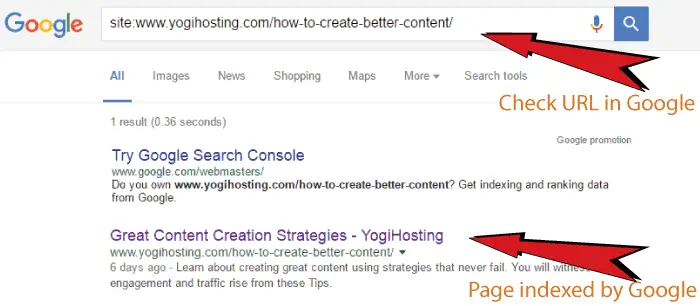
Internal Link
– A link, on a page of a website, to some another page of the same website is called as Internal Link.
Internal linking is good for SEO since is passes link juice from one page to another.
Internal links also decreases the bounce rate of your website.
Inbound Link
– Another name for backlinks which I have explained earlier.
J
JavaScript
– A script that runs on web browsers. It is used for many purposes like providing pop up messages, form validation, animations, etc.
jQuery
– A fast JavaScript library that simplifies and shortens the JavaScript code.
Loading speed of a website is a ranking factor for search engines and therefore it is always good to update your JavaScript code with faster jQuery.
K
Keywords
– A word or phrase that a user searchs in Search Engines. If you search SEO Tutorials in Google search then it will be the keyword.
Keyword Research
– Finding the most appropriate keywords to target in a website or web page. I would recommend you to use SEMrush SEO Tool for doing keyword research.
Keyword Stuffing
– Filling web page with lots of keywords, in an attempt to manipulate search ranking. Avoid keyword stuffing as your website will be penalized by search engines.
Keyword Density
– The percentage of occurrence of a keyword in a content. If a keyword appears 12 times in a 1000 words content then keyword density would be 12/1000*100=1.2%
Keyword density should be between 1.2% and 1.5% for getting best SEO benefits.
Keyword Cannibalization
– Targeting the same keyword in a bunch of pages and also keeping the same keywords in Page Titles, anchor tags and content.
It confuses Search Engines and will lead to poor rank for your website.
L
Link Building
– The process of getting backlinks to your website. Good SEO experts have powerful friends news agencies like cnn, forbes, bbc, and they provide them with good backlinks in these news portals.
Link Juice
– Authority and trust passed via link. All links except nofollow ones, passes link juice to the target URL.
It is a common funda that more links gives more juice to a URL, and that results in good SERP rank.
LSI
– Stands for Latent Semantic Indexing, these are the keywords that are linked to your main keyword.
Search Engines uses their own algorithm for finding out the LSI keywords when you search a term or phrase.
LSI Graph is a great tool for finding them out.
The LSI keywords for Steve Jobs would be ‘Apple’, ‘iPhone’, ‘pancreatic cancer’, ‘Laurene Powell’ and so on.
LSI keywords can be a great way to increase website traffic
Long Tail Keywords
– These are 3 or more words phrase that is very specific to the search. They help in narrowing down the scope of a search.
For Keyword windows 10 the Long Tail ones are ‘windows 10 download’, ‘windows 10 update’, ‘windows 10 anniversary update’, ‘windows 10 product key’ and so on.
You can find them directly from Google search as I have shown below.
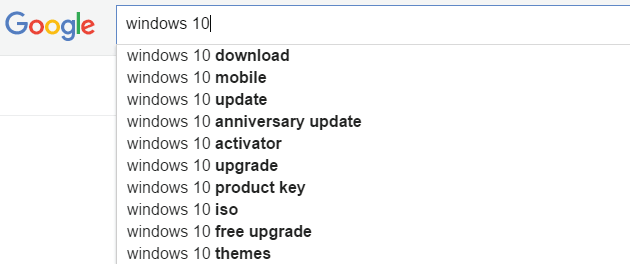
SEMrush is another way to find Long Tail keywords.
Link Exchange
– The process of exchanging links from one website to another. It should be avoided as it is against Search Engine policies.
Link Farm
– Group of websites that places each other links for the sole purpose of manipulating search rankings.
Search engines are smart enough to catch such link farms and ban each of the participating websites.
M
Meta Tags
– Tags that describe the content of a web page to search engines. They do not show in the page and are placed inside the page head section.
Place proper Meta tags in all your web pages so that search engines can understand what your page is all about.
Meta Description
– Part of Meta Tags, Meta Description is a snippet of information shown for every page in search results. It is roughly 155 characters long.

Meta Description’s syntax is:
<meta name="description" content="155 characters that describes your page content">
And it goes inside the page head section.
Make attractive meta description because it will get the user click SERP.
Meta Keywords
– Now no longer used by search engines so don’t place them in your web pages. They were part of Meta Tags that tells search engines what keywords the page is targeting.
Syntax is:
<meta name="keywords" content="keyword1,keyword2,keyword3,etc">
Monetize
– Generating income from your website by showing advertisements in it. Adsense is the easiest and the best platform to monetize your website.
N
Nofollow
– A HTML attribute that can be put in an anchor. It tells Search Engines not to pass link juice to the targeted URL.
Syntax:
<a href="some url" rel="nofollow"/>
- Here Search Engines will not pass link juice to ‘some url’.
- By default all anchor elements are dofollow which is totally opposite of nofollow.
- It is not required to put ‘dofollow’ attribute in anchor elements.
- Internal links should not be ‘nofollow’.
When placed in robots meta tag in the page’s head section, it will tell Search Engines not to index the page and not to index any links found in the page.
Syntax:
<meta name="robots" content="nofollow">
Noindex
– Directs search engines not to index a given page. It is placed in the robots meta tag in page head like:
<meta name="robots" content="noindex">
<meta name="robots" content="nofollow,noindex">
Niche
– Subject/Topic of focus of a website. CNN portal niche is current news.
O
Organic Search Results
– The web pages links (unpaid ones), shown by Search Engines, when some user does a search on them.
Those URLs, that matches most closely to the search query, get top positions.
Organic Traffic
– The unpaid traffic that comes to a website through search engines such as Google, Bing and Yahoo.
Suppose you search ‘current domain prices’ on Google. Then the unpaid results which it shows are the Organic Search Results. If you click on any of these links, to go to the website, then it will be the organic traffic the website received.
The most important goal of SEO is to get more Organic Traffic to the website.
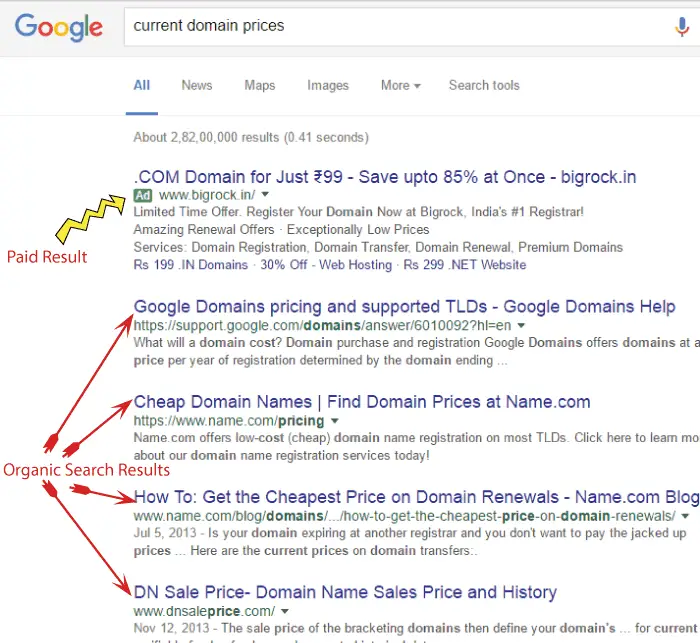
P
Page Rank
– Google founders Larry Page and Sergey Brin invented Page Rank algorithm in 1996 itself, a sort of ranking system where websites were given ranks from 0 to 10 (0 for lowest and 10 for highest), based on their popularity, authority and traffic.
It was the first algorithm (but not the only one) which Google search used from the starting, to generate search results.
It was discontinued in 2009.
Page Title
– Roughly 55 characters long, it defines a web page Title in the browser.
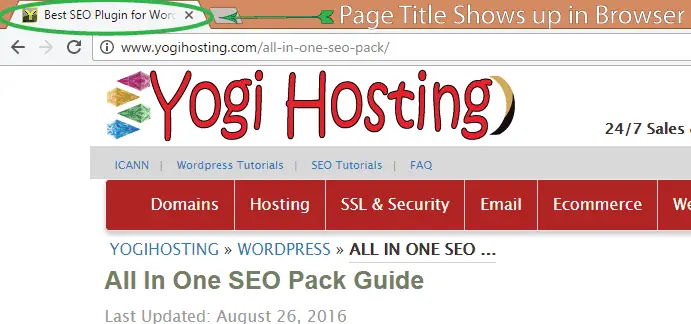
Page Title also shows up in SERP. It is a very important ranking factor and you should always keep the web page’s main keyword in it.
Panda Algorithm
– Google ranking algorithm first launched in February 2011. It’s work is to lower the rank of low-quality websites (website with lot of advertisements or with low quality content). This algo also brings ‘high-quality’ websites to the top of the SERP. Panda algorithm is updated from time to time.
Penguin Algorithm
– Introduced by Google in April 2012, its aim is to penalize websites that violates Google Webmaster Guidelines or uses some sort of Black hat SEO techniques.
Q
Query
– The search string entered by the user in Search Engines for the purpose of searching it.
R
Redirect
– Taking a visitor to a different URL then what he entered in the browser.
Registrar
– The Internet Company where you can register domain names.
Robots.txt
– It is a text file that sits on the website’s root folder and controls the behavior of search engine spiders.
It tells search engine spiders how to crawl and index pages of the given website. By using it, you can also prevent search engines not to index certain pages and directory files. It can also be used to prevent certain search engines from indexing the website. Like, you can allow Google to index your website but
prevent Bing and Yahoo to do so.
This site’s robots.txt file location is https://www.yogihosting.com/robots.txt. You can open the URL to see it.
Yes, you should have it as every search engine spider reads this file.
ROI (Return on Investment)
– The benefit received for the investment done.
Note: More than half of marketers say investing in a Video gives the best ROI.
RSS Feed
– RSS stands for Really Simple Syndication, a method to allow users to stay updated to a site’s new and updated contents.
Check the tutorial on How to Setup FeedBurner in your Website that covers every minute detail about this topic.
S
SEO
– Search Engine Optimization is a method of increasing traffic to a website by ranking the website higher in SERP.
To understand SEO perfectly, you have to understand all SEO Terms, which are explained in this tutorial.
SEM
– Search Engine Marketing is the process of gaining traffic from SERP by paid means. The ads shown in Google Search belong to SEM.
SERP
– Stands for Search Engine Results Page, it is the page where you see search results based on the string you searched for.
Sitemap
– A document which contains list of every page a website has, for the purpose of Search engines, to easily find and index them.
It is usually an XML file that resides in the root folder of the website.
Server
– Computer/Machine that contains or hosts website’s codes for serving them in the internet.
You cannot make a website live unless you host your website source codes in the server, and link them to your website’s domain name.
Stop Words
– Common words like a, and, the, to, from which offer little value.
Make sure to use minimum Stop Words in Page Title and Page URL because not only they take up space but are also ignored by Search Engines.
Social Media
– Websites which people use to interact with their friends.
Social Media Websites now include almost everything like different organization, businesses, news channels, games, chat rooms, etc.
Facebook, Twitter, Pinterest, Google Plus, all come under Social Media.
SMM
– Stands for Social Media Marketing, a process of marketing content or product in Social Media websites.
The Content is shared among users, which is then shared among other users and this continues, bringing tremendous exposure to the content.
For content marketers it is important to remain active on Social Media to bring trust among people.
T
Text Link
– Links that are placed on some text. Format of Text Link is :
<a href="some url">Link Text</a>
On the other hand the link placed on some image is an image link. Format of Image Link is:
<a href="some url"><img src="image url" alt="some text"/></a>
Trackback
– A type of notification that tells a website, if some external website has provided a link to it. WordPress has Trackback systems which lets bloggers to get notification when some other website links to them.
U
URL (Uniform Resource Locator)
– A web address of a web page through which it can be viewed in web browsers.
URL of every web page is shown in the address bar of the web browser.
The URL of Google is http://www.google.com.
URL Rewrite
– The process of making the web pages URL as SEO friendly. This is done so that they get a boost in SERP.
It is a must needed thing for every website. In URL Rewrite, the main keyword of the web page is generally placed in the URL.
No, since WordPress does URL rewriting by default. You only have to select the “Post name” for “Common Settings”, which is given at Settings > Permalinks section of your WordPress website.
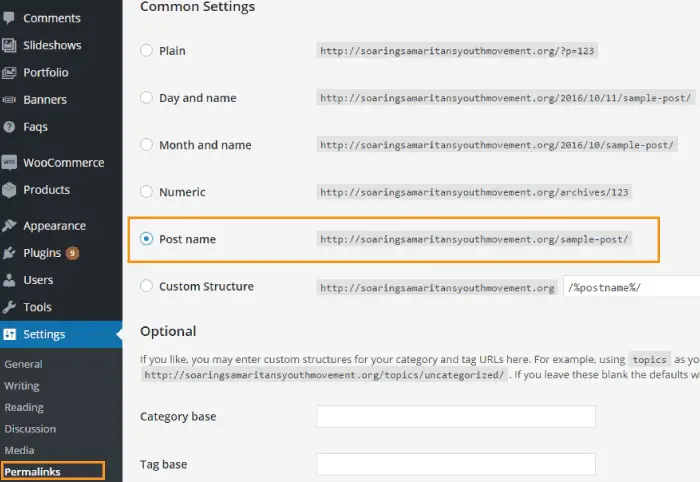
V
Viral Marketing
– Use of Social Media to promote a product so that it is spread from one person to another.
It is same like a virus spreading from one computer to another.
W
WHOIS
– An online database that stores information regarding domain owners, IP addresses of domains and other wide range of information.
Click Here to search Whois database for any website available in the Internet.
White Hat SEO
– SEO techniques for optimizing websites which focus on human audience and follows Search Engine guidelines.
- 1. Making Quality Content.
- 2. Getting Quality Backlinks from good and related websites.
- 3. Good navigation in the website.
- 4. Descriptive and keyword rich Page Title, URL and Meta Description.
- 5. No duplicate content.
X
XML (Extensible Markup Language)
– A markup language that is in the form of tree like structure and is used for storing and transporting data.
Sitemaps are generally made in XML.
Y
Youtube Marketing
– Marketing a product, service, brand or content in Youtube.
Youtube is world’s third most visited website after Google and Facebook.
Youtube keeps on making new people from around the world as “Internet Sensation”. We all know Gangnam Style by Psy which has made over 4 billion hits in Youtube.
Z
Zopim Chat
– A feature/functionality which allow your site visitors to chat directly with you. Zopim Chat is good for eCommerce websites.
Conclusion
Proper SEO is essential for the growth of a website and you should use them properly. Do you know some other SEO terms too? Then please share them in the comments section below.

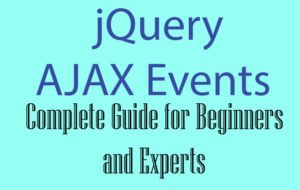
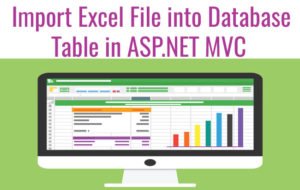
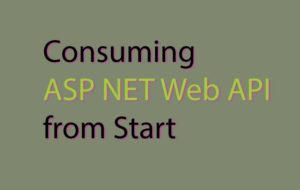
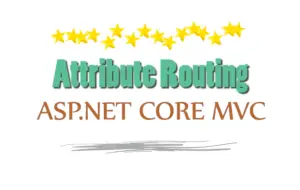
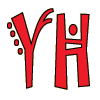



 Welcome to YogiHosting - A Programming Tutorial Website. It is used by millions of people around the world to learn and explore about ASP.NET Core, Blazor, jQuery, JavaScript, Docker, Kubernetes and other topics.
Welcome to YogiHosting - A Programming Tutorial Website. It is used by millions of people around the world to learn and explore about ASP.NET Core, Blazor, jQuery, JavaScript, Docker, Kubernetes and other topics.